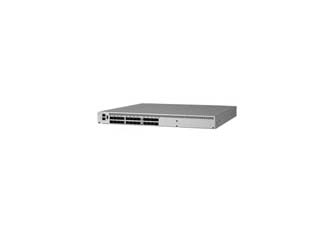Brocade 6505是一種24端口入門級交換機,可提供超高的性價比,集出色的靈活性、簡便性和企業級功能于一身。Brocade 6505交換機采用了市場領先的Gen 5 Fibre Channel(16 Gbps)技術,是業內安裝、管理和支持最簡便的SAN交換機。
1.概述
面向私有云存儲的靈活、簡便易用的入門級SAN交換機
為滿足不斷增長的業務需求,數據中心正遷移到高度虛擬化的私有云存儲環境。這種方法使企業可以整合并簡化IT資源,進而提高業務靈活性并降低資本支出和運營支出。但伴隨虛擬化而來的還有一系列挑戰。數據中心必須適應爆炸性數據增長和虛擬化工作負載帶來的動態變化。要實現這些基于云的架構的全部優勢,選擇適當的網絡是關鍵。
采用Gen 5 Fibre Channel(16 Gbps)技術的Brocade 6505交換機可提供超高的性價比,將出色的靈活性、簡便性和企業級功能無縫地結合到一臺入門級交換機中。Brocade 6505設計用于實現最高的靈活性和可靠性,有12或24端口兩種配置,而且可在高效的1U包裝中支持2、4、8或16 Gbps的速度。它標配有帶集成風扇的單一電源。可選的第2套電源可提供更高的冗余,來確保更高的彈性。
簡化的部署流程和點擊式用戶界面使Brocade 6505更加強大而且簡便易用。此外,Brocade 6505可幫助以很低的成本獲得行業領先的Gen 5 Fibre Channel技術的優勢,同時提供“邊增長邊付費”式可擴展性,來滿足不斷發展演進的存儲環境的各種需求。其它主要特性包括:
提供超高的性價比,在24端口1U高入門級交換機中結合出色的靈活性、簡便性和企業級功能
利用按需端口擴展(PoD)功能,快速、簡單而經濟高效地從12個端口擴展到24個
利用平滑的軟件升級和可選的冗余電源最大限度地提高彈性
利用Brocade EZSwitchSetup向導簡化部署
借助動態Fabric配置、關鍵性能監控和高級診斷特性簡化部署和故障排除,縮短時間
提供雙重功能,既可用作功能全面的Fabric SAN交換機,又可用作支持NPIV的Brocade Access Gateway,進而簡化服務器連接,提高SAN可擴展性
通過Brocade Network Advisor簡化并集中進行管理,降低運營成本和復雜性
2.特性
超高的性價比,支持不斷增長的SAN工作負載
Brocade 6505集市場領先的吞吐量和經濟的交換機外形設計于一身,是應對不斷增長的SAN工作負載的理想選擇。24個端口可提供總共384 Gbps的全雙工吞吐量;可將任意8個端口捆綁起來,形成128 Gbps的互聯鏈路捆綁(Inter-Switch Link,ISL)。基于交換的動態路徑選擇(DPS)可以優化全Fabric架構的性能,并通過自動將數據路由到Fabric架構內最高效的空閑路徑上來實現負載均衡。它可以進一步補充Brocade ISL鏈路捆綁,在特定配置中提供更有效的負載均衡。
此外,Brocade 6505的總體擁有成本(TCO)很低,因為它的12端口基本配置易于管理,只占用1U的機架空間而且能耗很低——每Gbps為0.22瓦,每端口為3.3瓦。企業級功能與很低的TCO相結合,與成本相當的同類其它萬兆以太網(10 GbE)解決方案相比可提供高40%的性能。
行業領先的技術,靈活、簡單而且簡便易用
Brocade 6505在靈活、簡單而且簡便易用的解決方案中提供行業領先的Gen 5 Fibre Channel技術。基本配置包含12個端口,可根據需要最多擴展到24個端口。除了提供最高的可擴展性之外,Brocade 6505還可以通過Brocade EZSwitchSetup向導和可簡化設置的全新“D_Port”特性來實現輕松部署。
虛擬化私有云存儲的有機組成部分
Brocade 6505為當前高度虛擬化的私有云存儲環境提供了一個關鍵組件。它可以簡化服務器虛擬化和虛擬桌面基礎架構(VDI)管理,同時滿足固態硬盤(SSD)的高吞吐量需求。Brocade 6505還可以通過服務質量(QoS)和基于Fabric架構的分區特性來在云環境中支持多租戶(multi-tenancy)。
Brocade Access Gateway模式
Brocade 6505可作為功能全面的Fabric架構交換機或作為Brocade Access Gateway(接入網關)進行部署,來簡化Fabric架構拓撲和異構Fabric架構連接(其默認模式設置是交換機)。Brocade Access Gateway模式利用N_Port ID Virtualization(NPIV)交換機標準來直接向SAN Fabric架構的核心顯示物理和虛擬服務器。這使Brocade Access Gateway對SAN Fabric架構完全透明,因此可大大減輕網絡邊緣的管理工作。以Brocade Access Gateway模式*運行的Brocade 6505可以將服務器連接到支持NPIV的Brocade B系列、Brocade M系列或其它SAN Fabric架構。
企業可以通過Brocade Network Advisor(博科網絡顧問軟件)或CLI輕松實現Brocade Access Gateway模式。Brocade Access Gateway模式的主要優勢包括:
更高的可擴展性,適合大型或快速增長的服務器和虛擬服務器環境
減少網絡邊緣的管理工作,因為Brocade Access Gateway沒有域身份,在核心Fabric架構看來是完全透明的
支持異構SAN配置,而不減少服務器連接功能
在入門級交換機中提供企業級特性
Brocade 6505在入門級交換機中提供先進的監控、診斷、RAS和冗余功能,來最大限度地提高可用性,優化性能并簡化管理。這些企業級特性包括:
關鍵的診斷和監控功能,可幫助確保盡早完成故障檢測和恢復
在每個端口上支持平滑、非破壞性監控,提供整個Fabric架構的端到端視圖
前向糾錯(FEC)可從ISL中的位錯誤中恢復,進而增強傳輸可靠性和性能
額外的緩沖器,可避免緩沖信用丟失導致的性能降低和擁塞
在ISL上根據主機/應用進行實時帶寬消耗量計算,識別熱點和潛在的網絡擁塞
可選的第2套電源,實現雙電源冗余,增強可用性
Brocade 6505的Brocade Access Gateway模式僅在24端口配置中受支持。
3.規格
| Fibre Channel ports | Switch mode (default): 12- and 24-port configurations (12-port increment through Ports on Demand [PoD] license); universal (E, F, M, D) ports Brocade Access Gateway default port mapping: 16 F_Ports, 8 N_Ports |
| Scalability | Full-fabric architecture with a maximum of 239 switches |
| Certified maximum | 6000 active nodes; 56 switches, 19 hops in Brocade Fabric OS fabrics; 31 switches, three hops in Brocade M-EOS fabrics; larger fabrics certified as required |
| Performance | Auto-sensing of 2, 4, 8, and 16 Gbps port speeds |
| ISL trunking | Frame-based trunking with up to eight 16 Gbps ports per ISL trunk; up to 128 Gbps per ISL trunk. Exchange-based load balancing across ISLs with DPS included in Brocade Fabric OS. There is no limit to how many trunk groups can be configured in the switch. |
| Aggregate bandwidth | 384 Gbps end-to-end full duplex |
| Maximum fabric latency | Latency for locally switched ports is 700 ns; Forward Error Correction (FEC) adds 400 ns between E_Ports (enabled by default). |
| Maximum frame size | 2112 byte payload |
| Frame buffers | 8192 dynamically allocated |
| Classes of service | Class 2, Class 3, Class F (inter-switch frames) |
| Port types | D_Port (Diagnostic Port), E_Port, F_Port, M_Port (Mirror Port); self-discovery based on switch type (U_Port); optional port type control Brocade Access Gateway mode: F_Port and NPIV-enabled N_Port |
| Data traffic types | Fabric switches supporting unicast |
| Media types | Hot-pluggable, industry-standard Small Form-Factor Pluggable (SFP+), LC connector; Short-Wavelength (SWL), Long-Wavelength (LWL); Extended Long-Wavelength (ELWL); distance depends on fiber optic cable and port speed. Supports SFP+ (8 and 16 Gbps) optical transceivers. |
| USB | One USB port for system log file downloads or firmware upgrades |
| Fabric services Note: Some fabric services do not apply or are unavailable in Brocade Access Gateway mode | Brocade Advanced Performance Monitoring (including Top Talkers for E_Ports, F_Ports, and Fabric mode); Brocade Adaptive Networking (Ingress Rate Limiting, Traffic Isolation, QoS); Bottleneck Detection; Brocade Advanced Zoning (default zoning, port/WWN zoning, broadcast zoning); Dynamic Fabric Provisioning (DFP); Dynamic Path Selection (DPS); Brocade Extended Fabrics; Enhanced BB credit recovery; Brocade Fabric Watch; FDMI; Frame Redirection; Frame-based Trunking; FSPF; IPoFC; Brocade ISL Trunking; Management Server; NPIV; NTP v3; Port Fencing; Registered State Change Notification (RSCN); Reliable Commit Service (RCS); Server Application Optimization (SAO); Simple Name Server (SNS) |
| Extension | Fibre Channel, in-flight compression (Brocade LZO) and encryption (AES-GCM-256); integrated 10 Gbps Fibre Channel for DWDM MAN connectivity |
| Management | |
|---|---|
| Supported management software | HTTP, SNMP v1/v3 (FE MIB, FC Management MIB), SSH; Auditing, Syslog; Brocade Advanced Web Tools, Advanced Performance Monitoring, Brocade Fabric Watch; Brocade Network Advisor SAN Enterprise or Brocade Network Advisor SAN Professional/Professional Plus; Command Line Interface (CLI); SMI-S compliant; Administrative Domains; trial licenses for add-on capabilities |
| Security | DH-CHAP (between switches and end devices), FCAP switch authentication; FIPS 140-2 L2-compliant, HTTPS, IPsec, IP filtering, LDAP with IPv6, Port Binding, RADIUS, User-defined Role-Based Access Control (RBAC), Secure Copy (SCP), Secure RPC, SFTP, SSH v2, SSL, Switch Binding, Trusted Switch |
| Management access | 10/100 Mbps Ethernet (RJ-45), in-band over Fibre Channel, serial port (RJ-45), and one USB port |
| Diagnostics | D_Port offline diagnostics, including electrical/optical loopback, link traffic/latency/distance; POST and embedded online/offline diagnostics, including environmental monitoring, FCping and Pathinfo (FC traceroute), frame viewer, non-disruptive daemon restart, port mirroring, optics health monitoring, power monitoring, RAStrace logging, and Rolling Reboot Detection (RRD) |
| Mechanical | |
| Enclosure | Back-to-front airflow (port-side exhaust); power from back, 1U |
| Size | Width: 437.64 mm (17.23 in.) Height: 43.18 mm (1.7 in.) Depth: 443.23 mm (17.45 in.) |
| System weight | 7.82 kg (17.25 lb) with one power supply, without transceivers 9.16 kg (20.19 lb) with two power supply FRUs, without transceivers |
| Environment | |
| Operating environment | Temperature: 0°C to 40°C/32°F to 104°F Humidity: 10% to 85% (non-condensing) |
| Non-operating environment | Temperature: –25°C to 70°C/–13°F to 158°F Humidity: 10% to 90% (non-condensing) |
| Operating altitude | Up to 3000 m (9843 ft) |
| Storage altitude | Up to 12 km (39,370 ft) |
| Shock | Operating: Up to 20 G, 6 ms half-sine Non-operating: Half sine, 33 G 11 ms, 3/eg axis |
| Vibration | Operating: 0.5 g sine, 0.4 grms random, 5 Hz to 500 Hz Non-operating: 2.0 g sine, 1.1 grms random, 5 Hz to 500 Hz |
| Heat dissipation | 24 ports at 338 BTU/hr |
| Power | |
| Power supply | Base switch includes a single, hot-swappable power supply with integrated system cooling fans. Optional dual redundant hot-swappable power supply. |
| AC input | 85 V to 264 V ~5 A to 2.5 A |
| Input line frequency | 47 Hz to 63 Hz |
| Power consumption | 80 watts with all 24 ports populated with 16 Gbps SWL optics 60 watts for empty chassis with no optics |
